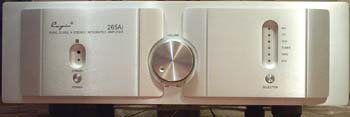Cayin 265Ai Integrated Class A Amplifier March, 2004 Arvind Kohli
|
|
|
Specifications
|
Until recently, I have exclusively reviewed solid-state designs with an A/B output class. So, I felt it was high time I tried a design rated at full Class A operation.
Well, let me tell you not a lot of these are available in an
integrated configuration. However, there are several integrateds rated as
Class A/B that have a moderate to high bias into Class A, the intent being
that for low to moderate listening levels operation would be in the Class A
mode. The previously reviewed Simaudio I-5 was one such model. Long story
short, I came across the Cayin 265Ai, and hence this review.
What is the big deal about Class A, you ask? Well, I am not qualified to do
more than repeat what I have learned from others on this topic, and there are
several excellent papers on the web dedicated to explaining Class A
amplification. The appeal to me is a design that is
simple and does not compromise the current available to the speaker for the
sake of efficiency. Basically, Class A means that the current is already
flowing in the output devices, and is diverted to the speakers when the
demand is there. With Class A/B, when the Class A power runs out, it is then
in Class B, which means that current has to be switched in when the demand
is there. This can slow things down a bit, and cause distortion.
The tradeoff is much higher power consumption and heat
dissipation (the current in Class A is dissipated as heat when it is not
flowing to the speakers), neither of which bothered me with this review subject. The amp
was placed on the top shelf of my rack and unencumbered on all sides, so the heat sinks were given plenty of circulation. The power consumption was about
200 watts regardless of output (rated output is 40 watts per channel). In contrast, my old Bryston 4B consumed about the
same at idle and went up to over 1900 watts at maximum output. I can actually plug
the Cayin into my P300 Power Plant along with my source components, now that is
worth quite a bit.
Company Profile
Zhuhai Spark Electronic Equipment Co., Ltd. was founded in 1993 to design and
manufacture audio products. It is a subsidiary of China National
Aero-technology Imp. & Exp. Corporation (CATIC), which was founded in 1981.
Their website claims Revenues of nearly USD $1 Billion for 2002. There is a
very elaborate structure of subsidiaries that links Spark to CATIC, the
details of which are completely irrelevant here. The only relevant piece
of information is that Spark seems to be backed by a large and well-established
Chinese conglomerate of high-tech products. That kind of technical
infrastructure and talent pool is bound to pay tangible dividends. Their
products are distributed in more than 20 countries, and claim to have
participated in audio shows in Tokyo, London, Milan, Frankfurt, Copenhagen,
Athens, Hong Kong and Taipei. They also supply OEM audio products to un-named
companies in Japan, Europe, USA, and Taiwan. There are 15 engineers on
staff. A statement from the company emphasizes their background with output
and power transformers. If they have a weakness, it seems to be in the
marketing, web design, and translation skills. As far as I am concerned, I am
only eager to forgive many shortcomings in those areas if the product is
something to behold.
The Cayin brand produces a variety of components, including two CD players, a
tuner, a mini-monitor, three other solid state integrateds, one solid state amp,
and a whole host of tubed amps, preamps and integrateds. The 265Ai is the
only solid-state Class A amp they make.
Setup
The Cayin was plugged into my PS Audio P300 Power Plant at all times, and
seemed to draw about 200 watts, which sounds right for an amp that delivers 40
wpc in pure Class A. Of course, the power consumption did not change with the
volume level, since the input and output of energy in a Class A amp is always
at the maximum value. The difference is that at higher output, more of the
energy is delivered to the speakers and less is dissipated as heat.
The amp is intended to be left on standby at all times and takes about 10
seconds to power up when turned on. About 10 to 15 minutes of idle seems to
get it fairly warm, and ready for use. Upon powering up the volume control
turns all the way to zero, which turned out to be a very handy feature for me,
since I have two very curious toddlers.
The Outside
I would have to give this amp very high marks for its stunning looks and clean layout. It is only available in a brushed aluminum finish, and I found it very attractive as such. The front panel has a large volume dial that provided perhaps the best control I have ever experienced, as getting to the desired level took only one try (I hope other manufacturers begin to realize how important this is). The left side has the power switch that brings the unit in and out of standby. Above it, in a recess are two lights; I could not get confirmation on what those lights indicated. My guess is the lower light indicates standby (green), transition (red), and power on (green), and the light above it probably indicated the amp is being over driven, but I was not able to get that to activate for the levels that I tested. On the right side a single button toggles through the various inputs, and the recess above it has six lights to indicate the active input. Done. No other bells, whistles, knobs, switches, meters, dials, sliders, buttons, LEDs, displays, etc. My definition of simplicity would not allow any more than this, and my need for functionality would not allow any less. A perfect balance.
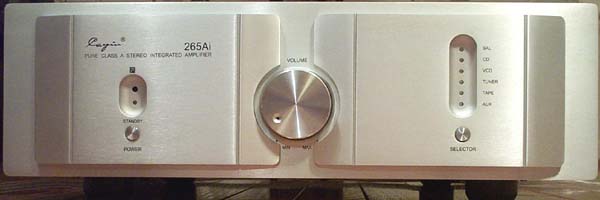
The rear panel features one set of XLR inputs, five sets of RCA inputs, and one set of RCA tape out. My only wish here is that there also was a pre-out. Speaker connectors were via a heavy-duty set of brass five-way binding posts that are well spaced. There also is an AC input for a detachable cord and the main power switch just above it. Again, the rear is simple, clean, and very thoughtfully laid out. The sides brandish the beefy heat sinks, mandatory for this output class.
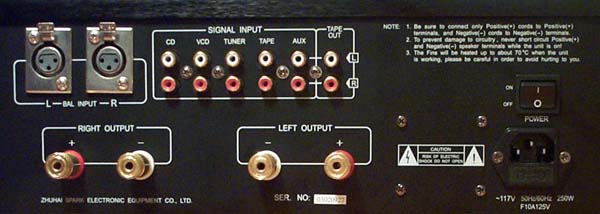
Fit and finish are outstanding. Sorry, no headphone jack, phono preamp,
balance, mute, mono, fixed level out, or other frill. Frankly, I was glad,
since I have no value for any of these features, and don't care to pay even
the nominal amount they would add to the cost. More importantly, I am glad
they were not included at the cost of cheaper parts elsewhere or needless
degradations to the signal path. I do wish there was a pre-out for a
subwoofer, but am not terribly heartbroken about it.
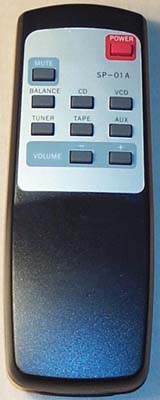 The
plastic remote is a full function and compact design, which easily fit into
the palm of my hand and was easy as pie to use. I am glad it was not some very
elaborate piece fashioned out of metal to give the impression of needless
quality. Again, I do not care to pay for those frills or have something else
compromised to make up for the cost that would have been lavished here.
The
plastic remote is a full function and compact design, which easily fit into
the palm of my hand and was easy as pie to use. I am glad it was not some very
elaborate piece fashioned out of metal to give the impression of needless
quality. Again, I do not care to pay for those frills or have something else
compromised to make up for the cost that would have been lavished here.
Technicals
The manufacturer's website and literature are lacking in detail and very
poorly translated. I had to rely on Mark Levine of Allied TV & Sound (North
American distributor) to supply the technical data. He in turn, had an
engineer on his staff bench test the specs quoted here. Interestingly enough,
the engineer decided to buy a unit immediately after completing his tests.
Input impedance is a very high 95 kOhms (all inputs), indicating that sources
with a very high output impedance will also be easily accommodated. The input
sensitivity is 500mv for full swing output, again this will be sure to
accommodate any source device I have heard of. The preamp section is fully
discrete, i.e., there are no integrated circuits in the output path.
The Dual mono layout starts with a 500VA Toroidal transformer for each channel.
These are EMI shielded and claim to have very low mechanical hum and vibration.
Power rating is 40 wpc, and does not change for loads from 8 ohms to 2 ohms.
Rail voltage is 100v maximum. Total capacitance is an astounding 40,000 μf per
channel. Available energy storage is 200 Joules.
Output devices are Toshiba Mosfets. Bandwidth is rated at 2 kHz - 30 kHz
± 0 dB. Slew rate
is better than 100v/μs. THD is rated lower than 0.05% at 1 kHz
and 0.1% at full bandwidth.
No wonder the distributor's engineer scooped up a
unit for himself after confirming the specs on his bench.
Warranty in North America is 3 years.
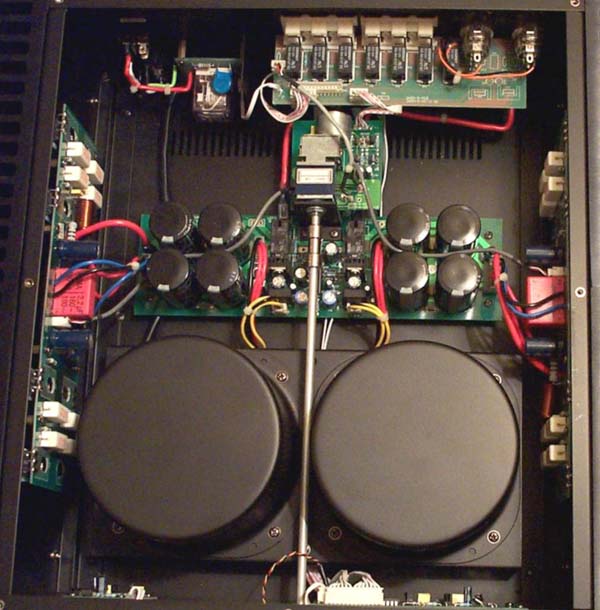
The Sound
All tests were done with the previously reviewed Dynaudio Contour 1.3 MkII
speakers and
Triangle Electroacoustique Titus 202 speakers. I also had the recently reviewed Creek
5350SE integrated amplifier on hand for direct comparison. To disallow bias due to varying volumes,
I measured two levels that registered at 60 dB and 80 dB at my listening spot (on
each speaker and amp), using a -20 dB pink noise test tone. Here are the
detailed highlights of my listening tests.
Coming of the Mandinka (Mumtaz Mahal; VM Bhatt, Taj Mahal, N Ravikiran;
Waterlily Acoustics; WLA-CS-46-SACD) has become a constant in my life for the
past few months. I am not sure if it is the fusion of Blues and Indian
Classical, or the purist recording with audiophile components that make this a
great album, but I just cannot stop listening to it. I started with the Creek
and was very impressed with the detail in the decay of the primary strings on
the three stringed instruments and the resonance of the sympathetic strings of
the two Veenas. I was also impressed with what that little integrated could do
in terms of staging and the dynamics of Taj Mahal's voice; that man can
effortlessly belt out an extra 10 decibels or more.
I slipped in the Cayin, and things moved up to a whole different level. My normal method of critical listening is to listen to about a one-minute segment repeatedly (say 10 to 20 times, allowing my short-term memory to retain as much detail as possible), and then switch in the comparative component and listen for differences. In most cases, I have to listen to the second component several times before I can distinctly pick out differences, and then I have to go back and repeat the process just to make sure I really heard those differences (Whew! I get tired just talking about it).
Well, with the Cayin
three differences were evident immediately. First, there was a large increase
in what is called macro dynamics. Whenever Taj Mahal would bellow out the
extra 10 decibels or so, it would feel like a very effortless and natural
increase. I never felt the Creek had a shortcoming in this respect (or any
other for that matter), until I heard the Cayin right behind it. The dynamic
range was so markedly increased that at times it felt like the volume level
was set much higher, but since I had done my homework on establishing volume
levels I knew that was not the case. Second, the strings on all three
instruments seemed fuller and more lifelike, to the point that I could almost
feel the physical impact of the string being plucked. Lastly, there was a
marked increase in the warmth and richness of the vocals, again making them
seem very natural and lifelike. This comparison was done with the Dynaudio at the
80 dB level.
Girl from Ipanema (Stan Getz, Joao Gilberto; Getz/Gilberto; Verve;
314-589-595-2) on SACD. The Cayin had a warmer and fuller sound in the
midrange compared to the Creek. Vocals had an obvious increase in what I would
call projection, and they seemed more lifelike. I cannot honestly say that I was
fooled into thinking that Gilberto was actually in the room, but that illusion
was substantially more felt with the Cayin than the Creek, or anything else I
can remember listening to. I could hear the smallest changes in Gilberto's
pitch or tempo, micro-dynamics is how this is often classified. I have never
before heard such subtle changes in a reproduced human voice, with the
perception being so immediate and effortless.
The Creek sounded noticeably different in the higher frequencies. I switched
back and forth between the amps several times, but could not quite put my
finger on what exactly that difference was. I almost wanted to say that with
the Creek the soundstage and the instruments within seemed a little more
distinct and spread out. Since I could not very clearly pick out the
differences, I picked out a few more tests to see if I could isolate and
distinguish what was going on. This test was done with the Dynaudios at the
60 dB level.
So I replaced the Dynaudios with the Triangles, which has relatively less
bass extension and would allow me to better focus on differences in the mid
and higher frequencies. The track I used was "General Image and Resolution
Test" (Chesky Jazz and Audiophile tests Vol. 2; Chesky; JD68), which involves a
purist recording of four musicians walking from the back of a hall towards the
microphone setup, circling the microphones and walking back out of the hall,
all while playing a different instrument each. This test helped clarify the
ambiguity I had in the previous test. The Cayin actually had a significantly
better separation of instruments, sonically and spatially. The maraca sounded
extremely lifelike, and I could track its movement around my room with extreme
certainty at all times. It felt like I could feel the musician walk
in front of me.
I also tried to follow the hand-drum player, and again it was much easier with the Cayin to be able to point him out with confidence. With the Creek, there were moments when I might have hesitated to try and estimate his location, or there were times when I knew where he should be, but my ears would not confirm that.
There were a couple of interesting things I noted with this test. The liner notes on the CD indicate that in near field listening, you should hear the musicians circle you. I could only perceive them walking in I circle in front of me. I suspect that is more due to my setup not being near field, rather than its resolution. Also, I first listened to this track with the Creek and then the Cayin. With the Cayin I immediately noticed that the circle the musicians were walking was farther out on the right side than the left. I quickly discovered the reason: I had accidentally toed in the right speaker a little less than the left. Now I did notice something askew with the Creek, but it only came to light as soon as I started listening to the Cayin.
Of course, this is not a
scientific conclusion that the Cayin is better. It is entirely possible that
my brain is so slow to recognize a lop-sided soundstage (and my wife would
agree about my being slow). Or, it took a long time to realize the slight
variation, which by then the Cayin just happened to be the amp playing. Maybe
I would have had the realization at the same time even if the Creek was still
playing. Personally, I would give the Cayin at least some credit for
highlighting the problem. I like that possibility, since it diminishes the
accusation of me being a dimwit. This test was done with the Triangles at the
80 dB setting.
My expectations of this amp were snowballing into avalanche proportions. I
started to expect enormous differences on every track I listened to, but I was
quickly brought back to reality with "All or Nothing at All" (Diana Krall;
Love Scenes; Impulse; IMPD233). Now don't get me wrong, there were obvious
differences, but they were just not as easy to pick out or as large as I had
expected. This could, in part, be due to the fact that this was the first
critical listening session with a recording not from an audiophile label or in SACD format. This indicates that the magnitude of differences noted above are
so small that they are noticeable only when listening to a high resolution
format or a high resolution recording.
On the double bass intro it was easier to delineate the plucks with the Cayin than the Creek. There were several "things" I heard with the Cayin I thought I had never heard before, but when I switched in the Creek they were surely there, but just not as prominent.
When I say "things" I am referring to sounds so subtle and short in duration that I cannot with certainty say what they were; possible examples are a fingernail hitting the body of a guitar, a gasp of air, a slap on a thigh, etc. It is the minutest piece of audible detail, but often too vague or unfamiliar to describe. The more readily I hear these "things", the higher I rate a component for detail.
On this track, there also was a touch more warmth and life in her voice, but
what was really obvious was the dynamic range. It was plainly
obvious to perceive large and small changes in her voice, the transitions were
effortless and immediate. Again, I had never noticed anything lacking with the
Creek, till I heard it through the Cayin.
For a while now, I have been feeling a little frustrated with my Dynaudio
Contour 1.3 MkII speakers. I am absolutely in love with the
Triangle speakers, but they have one
big limitation: they lose their charm at lower listening levels (specifically,
the level I calibrated as 60 db, or anything lower). I have two young kids who go
to bed early, and a house with all the rooms on the main floor connected via
large openings, allowing sound to travel unimpeded. Thus, I have not had very
much time listening to them in the way I would love to, i.e., at the volumes
they really come to life at. Well, the Cayin has changed that for reasons
unknown to me. I can conclusively say that listening to the 1.3 MkII has
become just as pleasurable at lower volumes as at higher ones now.
Curious about the reason behind this, I called Al Fillipelli of Dynaudio. His
explanation was that the drivers of the Dynaudio Contour 1.3 MkII have large
ferrite components that are highly inductive, i.e., have a tendency to hold a lot
of current. That is why the speaker fully comes to life only when
supplied with an adequate amount of current. Class A/B amps are designed to
supply only the amount of current needed at the time, and there is a time lag
between demand and supply. Hence, the perception of 'sluggishness' or 'lack of
speed'. According to Al, Class A/B amps delivers full current only at the top of
their RMS sine wave. In contrast, a Class A amp has full current on the rails
at all times, usually being wastefully dissipated into heat, but it is there
and ready to go. It delivers the required current as needed (within its
capacity) with virtually no lag, hence the perceptions of the sound being
'alive' and 'immediate'.
Mike Manousellis of Dynaudio also explained that the Cayin is likely a product
of high resolution, and that improvement is apparent through the very neutral
and transparent Dynaudio. When he learned that it was the Cayin that had caused
me to call him, he mentioned that he had recently spoken to an acquaintance
that owns the $30,000/pr Dynaudio Temptation and had also paired it with the
Cayin. Seems like this gentleman was even more impressed than I was, and found
the Cayin to be just as good as a to-remain-unnamed $18,000 amp. His
enthusiasm for the Cayin being greater than mine could be for two good reasons.
First, the Temptations are very likely to be much more revealing than my
Contour 1.3 MkII. Second, I am as miserly with praise as I am with money, my
wife will verify on both accounts.
To offset this good fortune, the Cayin also produced another change in my
perception. I now do not like my Triangle Titus 202 speakers as unequivocally as I used
to. I always felt that the Titus did a marvelous job in the midrange and mid
to upper bass. However the high frequencies were not as refined as the
presentation of the rest of the spectrum. But I never perceived that
discrepancy to be large enough to impede my overall enjoyment of that
speaker. As a matter of fact, it has been one of my all time favorite audio
products. It still is, but now the caveat attached has grown considerably.
On
many and several tracks, the Cayin plainly illustrated how wide the gap between
the tweeters on the Titus and Dynaudio Contour 1.3 MkII really is. While with
the Contour there was an immense amount of detail (perhaps the most I have
ever experienced with any amp), the treble was smooth and natural. In contrast,
the Triangle, while also quite detailed, tended to sound relatively harsh. I
thus have to alter my verdict on the Titus. I still highly recommend it, but
either with amps of moderate resolution or high-resolution amps with rolled
off highs. I suspect high-resolution tube amps may be just the ticket. When the
Triangles were returned to the second system to be mated with a NAD 317
Integrated, I enjoyed them just as ever. I am not sure if the NAD is of lesser
resolution or has the highs rolled off, but I would have to guess at least one
of the two must be true.
Conclusions
The clichė used ad nauseum by many reviewers is "This component (on hand) is better
than those costing several times as much". Well, if everything is better than the
average, then what exactly is average? But, I better get off that soapbox,
before I digress too much. I would not be surprised if the 265Ai indeed is
better than much pricier gear, but I did not have anything that expensive
on-hand to compare to. I did compare it to the slightly pricier Creek 5350SE
($1500) and found that I preferred the Cayin by a wide margin.
At this point, I should write several lines with various superlatives (perhaps
even invent a few), and prostrate myself to the virtues of this amp. But, like
I said above, I am not lavish with praise. However, let me summarize how I feel
about this amp by saying I bought one for myself, and it will be my reference
for the foreseeable future. Period.
When I clearly prefer a component to a venerable competitor in its price
class, I become very curious about how it would stack up against other highly
regarded models. Rest assured, I intend to pursue that train of thought in
future reviews.
Outstanding!
- Arvind Kohli -
Associated Equipment:
Dynaudio Contour 1.3 MkII Speakers
Triangle Electroacoustique Titus 202 Speakers
ACI Force Subwoofer
Creek 5350SE Integrated Amp
Sony DVP-NS755 CD/DVD/SACD Player
PS Audio P300 Power Conditioner
Cables: Homemade

